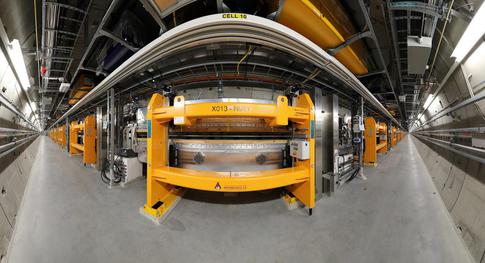XFEL: Expanding horizons with a new instrument
Expanding horizons with a new instrument

Panorama view of the SASE3 beamline, which feeds SQS and SCS, and will now include SXP. Photograph by Dirk Nolle (Copyright: DESY)
Work is on full swing to construct the new European XFEL instrument SXP. Manuel Izquierdo, who is the Group Leader for SXP since December 2020, gave insights into how the instrument will expand the European XFEL portfolio, when it is set to begin operations and what his vision is for the instrument at this stage.
How would you describe the SXP instrument?
SXP stands for “Soft X-ray Port”. This name was chosen in keeping with the core idea of the project, that is, to provide the users an FEL beamline where they can temporarily set up their own experiment stations. And, this is what makes the instrument unique: users can bring and operate their own experiment stations. This will allow many techniques and experiments to be implemented. The successful proposals would be those that cannot be performed at the two soft X-ray instruments SCS or SQS. So basically, the idea is that the SXP instrument will expand the portfolio of techniques available to users at European XFEL.
What kind of experiments will be performed at SXP?
In principle it is up to the user community to suggest. So far, three communities have contributed to the project. One community aims to use European XFEL as a laboratory for astrophysics, atomic physics, and fundamental research investigating highly charged ions. A second community proposed studies on chemical bond activation in biological reactions and inorganic catalysts. The third and biggest community aims to perform time and angle-resolved photoelectron spectroscopy experiments in solids. This technique will allow understanding the atomic structure, chemical, electronic and magnetic properties of materials. The counter part for atoms, molecules and clusters can be done at the SQS instrument.
How will the experiments being planned for SXP address some societal challenges?
All these directions follow the grand challenges that European XFEL is trying to address. For example, some proposed studies will allow us to investigate materials with applications in information storage, quantum computing or energy conversion. Catalytic studies will contribute to reducing the environmental damage of car exhaust gases and improving the petrochemical industry. Studies on highly charged ions will allow understanding atmospheric processes that heavily influence our environment, global warming and climate changes.
When was the decision taken to install the instrument? When do you see operations beginning?
The decision to realise the project was taken by the Council in June 2020. Because a lot of work is already done, also with participation of the tr-XPES User Consortium, we are now in a position to start implementation soon after the civil and infrastructure construction. I can proudly say that the SXP project is already in an advanced stage. Together with the contributions from the time-resolved photoelectron spectroscopy (tr-XPES) and now with SXP, we are aiming to have the first X-ray photons in the second half of 2022 and hopefully users can start work at SXP in 2023. Time and angle resolved photoemission technique will be the first technique to be implemented. The decision follows the SAC recommendation to prioritize the implementation of this technique at SXP.
As the group leader, what future directions do see for SXP? How would you like to shape its programmes?
The shaping of the future programme is priority for me and I would like to do it in synergy with the user community. Afterall, SXP is an “Open Port”! And I see many possibilities indeed. SXP will provide one of the few implementations of angle resolved photoemission with femtosecond soft X-ray pulses worldwide. I hope we will be able to go beyond the limits and study solid-liquid interfaces, catalytic reactions, bio-objects, and more. I would also like to be able to combine techniques since the laser and X-ray interaction with matter produces many signals that are not currently detected in a single experiment.
